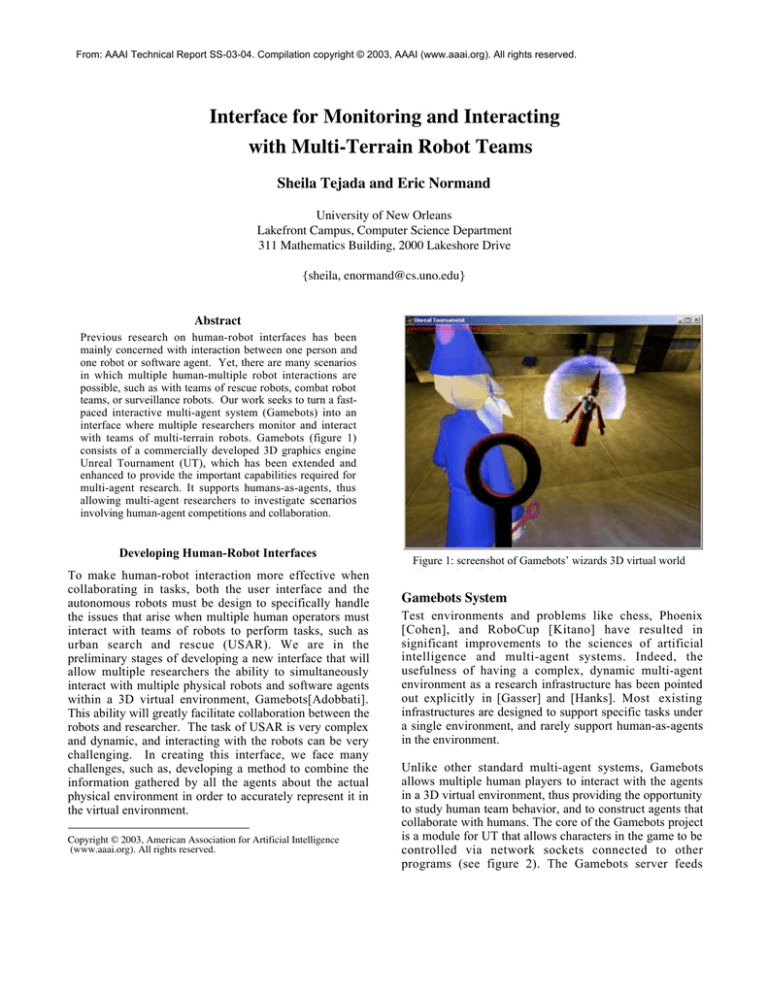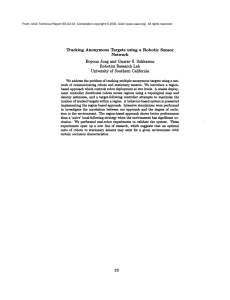
From: AAAI Technical Report SS-03-04. Compilation copyright © 2003, AAAI (www.aaai.org). All rights reserved.
Interface for Monitoring and Interacting
with Multi-Terrain Robot Teams
Sheila Tejada and Eric Normand
University of New Orleans
Lakefront Campus, Computer Science Department
311 Mathematics Building, 2000 Lakeshore Drive
{sheila, enormand@cs.uno.edu}
Abstract
Previous research on human-robot interfaces has been
mainly concerned with interaction between one person and
one robot or software agent. Yet, there are many scenarios
in which multiple human-multiple robot interactions are
possible, such as with teams of rescue robots, combat robot
teams, or surveillance robots. Our work seeks to turn a fastpaced interactive multi-agent system (Gamebots) into an
interface where multiple researchers monitor and interact
with teams of multi-terrain robots. Gamebots (figure 1)
consists of a commercially developed 3D graphics engine
Unreal Tournament (UT), which has been extended and
enhanced to provide the important capabilities required for
multi-agent research. It supports humans-as-agents, thus
allowing multi-agent researchers to investigate scenarios
involving human-agent competitions and collaboration.
Developing Human-Robot Interfaces
To make human-robot interaction more effective when
collaborating in tasks, both the user interface and the
autonomous robots must be design to specifically handle
the issues that arise when multiple human operators must
interact with teams of robots to perform tasks, such as
urban search and rescue (USAR). We are in the
preliminary stages of developing a new interface that will
allow multiple researchers the ability to simultaneously
interact with multiple physical robots and software agents
within a 3D virtual environment, Gamebots[Adobbati].
This ability will greatly facilitate collaboration between the
robots and researcher. The task of USAR is very complex
and dynamic, and interacting with the robots can be very
challenging. In creating this interface, we face many
challenges, such as, developing a method to combine the
information gathered by all the agents about the actual
physical environment in order to accurately represent it in
the virtual environment.
Copyright © 2003, American Association for Artificial Intelligence
(www.aaai.org). All rights reserved.
Figure 1: screenshot of Gamebots’ wizards 3D virtual world
(b) 2D visualization tool
Gamebots System
Test environments and problems like chess, Phoenix
[Cohen], and RoboCup [Kitano] have resulted in
significant improvements to the sciences of artificial
intelligence and multi-agent systems. Indeed, the
usefulness of having a complex, dynamic multi-agent
environment as a research infrastructure has been pointed
out explicitly in [Gasser] and [Hanks]. Most existing
infrastructures are designed to support specific tasks under
a single environment, and rarely support human-as-agents
in the environment.
Unlike other standard multi-agent systems, Gamebots
allows multiple human players to interact with the agents
in a 3D virtual environment, thus providing the opportunity
to study human team behavior, and to construct agents that
collaborate with humans. The core of the Gamebots project
is a module for UT that allows characters in the game to be
controlled via network sockets connected to other
programs (see figure 2). The Gamebots server feeds
simulating physics. UnrealScript can also be used to build
small mutator scripts that implement small tweaks, such as
adding or replacing world items, adjusting physics
parameters, or changing item effects. Such mutators can
be added at runtime to any existing game type, including
the those for Gamebots. The Unreal Tournament server
implementations exist for Windows, Linux, and Macintosh.
Additionally, the use of an open network protocol means
that client implementations are not bounded by platform
and can often integrate easily with existing intelligence
engines.
Current Status
Figure 2: 2D auxiliary visualization tool
sensory information for the characters over the network
connections. Based on this information, the client program
can decide what actions the character should take and
issues commands back over the network to the game to
have the character move, shoot, or talk. Agent programs
must display advanced AI and MAS capabilities to perform
successfully -- they must plan paths, learn a map of their
3D environment, use resources available to them,
coordinate and collaborate with their teammates, and
engage in strategic planning which takes their adversaries
into account.
We are in the initial stages of this project to use Gamebots
as an interface for monitoring and interacting with multiterrain robot teams. Currently, we are in the process of
interfacing Gamebots with a team of urban search and
rescue robots consisting of four legged robots, one wheeled
robot and two aerial robots. The team monitors the indoor
environment of an office building. Other challenges will
be to design the interface to allow researchers to adjust the
autonomy of the agents, ranging from completely
autonomous to teleoperation. We also plan to further
enhance the 2D auxiliary visualization tools with new
features, such as the displaying of vital task statistics for
real-time analysis and planning.
References
Adobbati, R., Marshall, A.N., Scholer, A., Tejada, S.,
Kaminka, G.A., Schaffer, S., Sollitto, C. (2001). GameBots:
A 3D virtual world test bed for multiagent research. In
Proceedings for the Second International Workshop on
Infrastructure for Agents, MAS, and Scalable MAS,
(Montreal, Canada, 2001).
Cohen, P.R., Greenberg, M.L., Hart, D.M., and Howe, A.E.
Trial by Fire: Understanding the design requirements for
agents in complex environments. AI Magazine, 10(3):3248.
Figure 3: Gamebots architecture
Figure 2: Gamebots architecture (note that
human
Unreal
Tournament
falls into to
a category
of videoand
games
players
connect directly
the UT server,
known as first-person shooters, where all real time players
bots connect
through
the exist
Gamebots
(currently
a maximum
of 32)
in a 3DModule).
virtual world
with simulated physics and a variety of tools (often
weapons) that give the players additional abilities. As
implied by ‘first person’ in the genre’s name, every
player’s senses are limited by their location, bearings, and
occlusion within the virtual world. Developers can extend
the existing games, or implement new ones using
UnrealScript. UnrealScript is a C++ based scripting
language that handles all game logic and object interaction
under Unreal Tournament while the main game engine
handles the hardcore work like ending scenes and
Gasser, L. MAS Infrastructure Definitions, Needs, and
Prospects. Working Paper LG-2000-07, 5/12/2000, in
Proceedings of the Workshop on Scalable MAS
Infrastructure, Barcelona, Spain, 2000.
Hanks, S., Pollack, M. E., Cohen, P., Benchmarks, Test
Beds, Controlled Experimentation, and the Design of
Agent Architectures, AI Magazine vol.14, p17-42, 1993.
Kitano, H., Tambe, M., Stone, P., Veloso, M., Coradeschi,
S., Osawa, E., Matsubara, H., Noda, I., and Asada, M. The
RoboCup Synthetic Agent Challenge 97. Fifteenth
International Joint Conference on Artificial Intelligence,
Nagoya, Japan, 1997.


